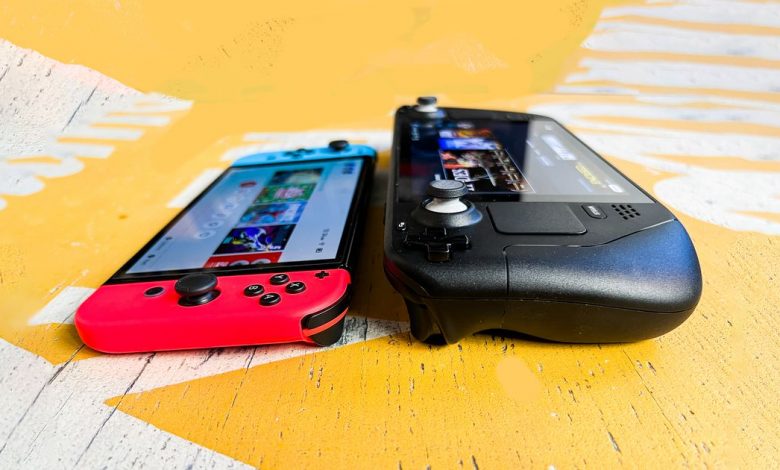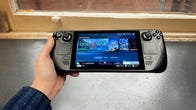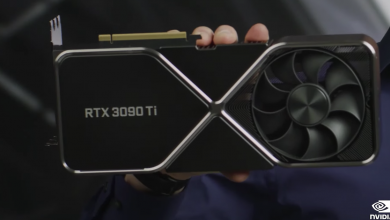Valve Steam Deck vs. Nintendo Switch OLED: Specs Compared

[ad_1]
The new Valve Steam Deck and veteran Nintendo Switch are a bit of an awkward pair to compare. But any gaming handheld device that looks even remotely like the iconic Switch — in other words, has controllers positioned on either side of a screen — gets sucked into the Switch’s vortex. The two do compete for the same money in many people’s budgets, much the same way Netflix and Spotify compete for your entertainment dollars, but there’s little in their specs to tell you which direction to toss the bucks. But for the moment, at least, the two offer very different experiences, because they’re aimed at very different audiences.
The Steam Deck, at least in its initial incarnation, is for tinkerers, tweakers, twiddlers and others for whom the fun of getting a game to run and to play well is as much fun as actually playing it — or at least doesn’t detract from it. But you don’t need the specs to tell you that, though the Deck’s checkboxes for end-user upgradability and moddable operating system are big flags. The Switch is for those who just want to play. And for kids with parents who want some control over what they play and for how long.
In fact, I think the Steam Deck’s biggest competitor is a phone or tablet running GeForce Now (which also lets you plan a subset of your Steam games, just like the Steam Deck) and the Switch’s is any phone or tablet with mobile-specific or cloud-streamed games.
Steam Deck and Nintendo Switch OLED specs
| Valve Steam Deck | Nintendo Switch OLED | |
|---|---|---|
| Price | $399, $529, $649 | $350 |
| Dimensions | 11.7 x 4.6 x 1.9 in (298 x 117 x 49mm) | 4 x 9.5 x 0.6 in (102 x 241 x 15.2 mm) |
| Weight | 23.6 oz (669g) | 14.9 oz (422g) |
| Screen | 7 in. IPS, 1,280 x 800, 400 nits, 60Hz | 7 in. OLED, 1,280 x 720 (1,920 x 1080 external) |
| Controls | Touch, dual trackpads with haptic feedback, buttons, triggers, thumbsticks | Touch, removable Joy-Con controllers with triggers, thumbsticks, buttons |
| Processor | AMD APU with quad-core Zen 2 CPU, 8 compute-unit RDNA 2 GPU (4-15w) | Custom Nvidia Tegra |
| Memory | 16GB soldered LPDDR5 | n/a |
| Storage | 64GB eMMC or 256-512GB SSD, micro SD (UHS-1) expansion slot | 64GB, micro SD expansion slot (up to 2TB), Nintendo Switch game cards |
| Connectors | USB-C for external display (8K at 60Hz or 4K at 120Hz), charging and dock/peripherals | USB-C for charging and dock |
| Connectivity | Wi-Fi 5, Bluetooth 5 | Wi-Fi 5, Bluetooth 4.1 |
| Audio | Stereo speakers, dual mics, 3.5mm combo analog | Stereo speakers, 5.1 surround via HDMI, 3.5mm combo analog |
| Battery | 40Wh (rated at approx. 7-8 hours) | 4,310 mAh (rated at approx. 4.5-9 hours) |
| Upgradable | Yes | No |
| Operating System | SteamOS 3.0 (Linux) | Nintendo proprietary |
| Game compatibility | 444 verified as of Feb. 27, 2021 | More than 5,000 |
| Other | Six axis positioning gyro | Multiangle kickstand, accelerometer, gyro |
| Accessories | Docking Station with HDMI 2.0, 1Gb Ethernet, USB-C power, 2 x USB-A | Alternate Joy-Con controllers, Dock with Ethernet and HDMI connections |
There are a lot of specs you can trot out to compare the two handheld gaming devices, but to me the most important ones are the basics: size and weight. That’s because the specs for the two models are effectively similar in almost every way save those, and for some people — notably kids and others with small-to-medium hands — the Steam Deck’s size and heft may rule it out. Or at least throws a big question mark over how comfortable it will feel for even moderately long sessions. The Switch is a lot smaller and lighter.
It doesn’t really matter that the Steam Deck has a more powerful and more recent processor and more storage: The Steam games it’s intended to play are written for PCs, so it needs a ton of storage and beefier silicon. Switch games are lightweight versions designed to run on the lesser processor in that handheld. Battery life is important, but can vary wildly depending upon the games you play, something that battery specs don’t properly convey.
The screen technology does matter — IPS for the Steam Deck and OLED for the newest top-end Switch, both 7 inch panels but with slightly different aspect ratios of 16:10 vs. 16:9. But even there it also matters how specific games use the screen as to the difference it makes.
Dan Ackerman/CNET
In his review of the Steam Deck, Dan Ackerman says “PC gaming devotees are the ideal audience – we’re already used to tweaking and troubleshooting, installing mods and drivers, and swapping out or overclocking hardware components. For some games, you’ll be digging into the options and settings and actively troubleshooting so they play well – or play at all. Other games, especially those listed as “Verified” by Valve, work right out of the box. Those are usually console-esque games with gamepad controller support, such as God of War.”
James Martin/CNET
Reviewer Scott Stein says of the Switch “We’re four and a half years into Nintendo’s Switch console lifecycle, and there are tons of great games. But, also, the Switch clearly lacks the graphics punch of next-gen consoles like the PS5 and Xbox Series X. Mobile games and iPad games keep getting better. There are a lot of ways to play games. The Switch is still a wonderful library of Nintendo and indie games and other stuff too, and a stellar family device, but it’s just one slice of an ever-growing gaming universe.”
[ad_2]
Source link









